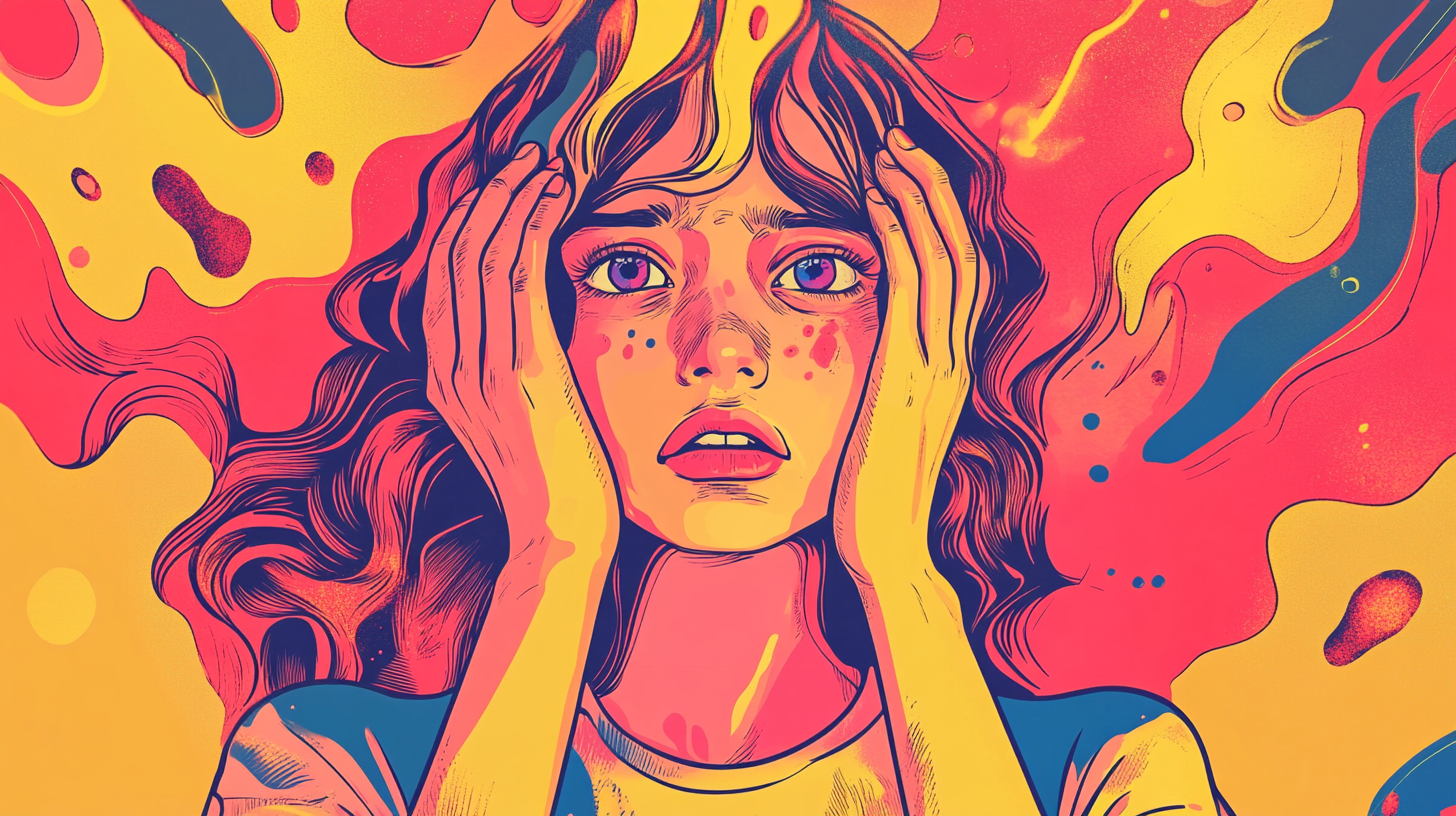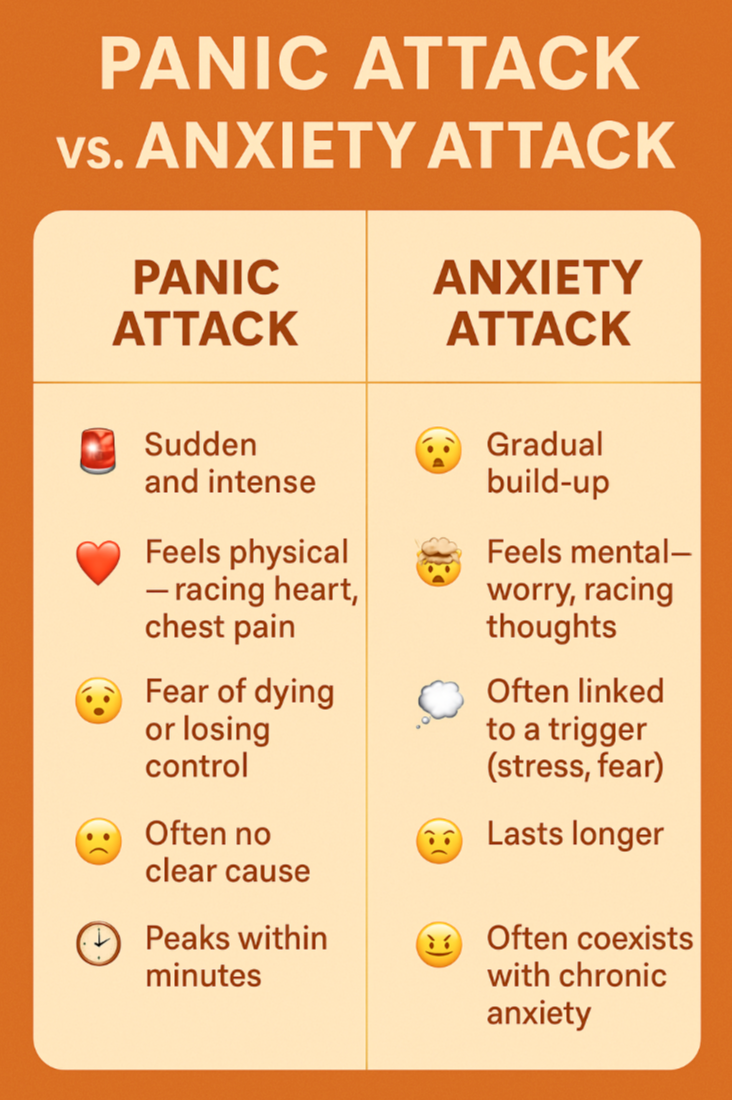Panic Attack vs. Anxiety Attack: What’s the Difference, and Why It Matters 🤷♂️
Confused about panic vs. anxiety attacks? You’re not alone. This guide breaks down key differences, symptoms, and how to respond—so you can name what you're feeling and start to take control.

It starts with your heart racing. Or maybe it’s a sudden wave of dread, like you’ve forgotten something important. Your breath shortens. Time warps. You can’t quite name what’s happening — only that something feels wrong. Really wrong.
If you’ve been there, you’re not alone. Millions of people experience episodes of intense fear and discomfort every year. But when we try to explain what’s happening, things get murky fast. Was it a panic attack? An anxiety attack? Are those even different?
The internet says yes. Your friend says no. And your brain — mid-spiral — doesn’t care about the terminology. But understanding the difference between a panic attack and an anxiety attack isn’t just academic. It matters. Because when you can name what’s happening, you can start to respond with clarity, not fear.
So let’s break it down. Calmly. Compassionately. Clinically.
Why the Confusion Exists 😵💫

Here’s the honest truth: even professionals don’t always use these terms consistently. That’s because only one of them — panic attack — is a recognized clinical diagnosis. The other — anxiety attack — is more of a colloquial catch-all. It’s often used by people to describe a buildup of overwhelming stress or fear, but it’s not formally defined in the Diagnostic and Statistical Manual of Mental Disorders (DSM-5), the gold standard for diagnosing mental health conditions.
This discrepancy leaves a lot of room for confusion — and frustration.
“Language shapes how we think about our experience,” says Dr. Jenny Taitz, a clinical psychologist and author of How to Be Single and Happy. “When people use ‘panic’ and ‘anxiety’ interchangeably, they might overlook important differences in how these conditions present and how they’re treated.”
Panic Attack: The Clinical Snapshot 📸

Let’s start with what we do know.
A panic attack is a sudden episode of intense fear that triggers severe physical reactions — often without an obvious cause. According to the DSM-5, a panic attack is defined by a rapid onset of symptoms that peak within minutes and includes at least four of the following:
- Pounding or accelerated heart rate
- Sweating
- Trembling or shaking
- Shortness of breath or a feeling of choking
- Chest pain
- Nausea or abdominal distress
- Dizziness or lightheadedness
- Feelings of unreality or detachment (derealization or depersonalization)
- Fear of losing control or “going crazy”
- Fear of dying
- Numbness or tingling
- Chills or hot flashes
These attacks can occur as part of Panic Disorder, but they also show up in other anxiety conditions, PTSD, or even out of the blue.
What makes panic attacks especially jarring is their speed. One minute you’re grocery shopping. The next, you’re gripping the cart like it’s a lifeboat.
Anxiety Attack: The Not-So-Official Cousin 👨👩👧👦

An anxiety attack, on the other hand, doesn’t have a formal diagnostic definition. But that doesn’t mean it’s not real.
People use the term to describe a state of overwhelming fear, worry, or nervousness that builds gradually — often in response to a stressor (like an upcoming deadline or confrontation). Symptoms vary widely but commonly include:
- Restlessness or agitation
- Muscle tension
- Trouble sleeping
- Difficulty concentrating
- Irritability
- Racing thoughts
- Physical symptoms like fatigue, stomachaches, or tight chest
Unlike panic attacks, which are more like emotional tsunamis, anxiety attacks tend to resemble slow-burning wildfires — they build over time, can last longer, and may not involve the intense fear of death or loss of control that defines panic.
“Anxiety attacks are more subjective and personalized,” says Dr. Luana Marques, a Harvard psychologist and anxiety specialist. “They may not fit into a neat checklist, but they still deeply affect a person’s quality of life.”
Key Differences: Panic Attack vs. Anxiety Attack 🔑

| Feature | Panic Attack | Anxiety Attack |
|---|---|---|
| Definition | Clinically defined in DSM-5 | Not formally recognized |
| Onset | Sudden, often without warning | Gradual, in response to stress |
| Duration | Peaks within 10 minutes | Can last for hours or longer |
| Symptoms | Intense physical sensations (e.g., heart racing, chest pain, fear of death) | Primarily mental/emotional (e.g., worry, tension), with some physical |
| Triggers | Often unknown or internal | Usually linked to specific stressors |
| Resolution | Often subsides within 30 minutes | Can linger and vary in intensity |
How to Respond to Each 🌓

Knowing what kind of episode you’re dealing with can shape your response — both in the moment and after.
If It’s a Panic Attack: 💡
- Ground yourself: Try the 5-4-3-2-1 method (name 5 things you can see, 4 you can touch, etc.)
- Remind yourself: “This will pass.” Panic attacks are intense but temporary.
- Control your breathing: Slow, deep breaths can help calm the autonomic nervous system.
- Find a safe space: If possible, remove yourself from overstimulating environments.
If It’s an Anxiety Attack: 💡
- Name the fear: What are you actually worried about? Naming it can reduce its power.
- Engage your body: Gentle exercise, stretching, or walking helps release built-up tension.
- Challenge the thought spiral: Ask, “What’s the worst that can happen — and could I handle it?”
- Use calming tools: Journaling, tea, guided meditation, or music can soothe your nervous system.
When to Get Professional Support 👨⚕️

Occasional anxiety or panic is part of being human. But if these episodes are frequent, interfere with daily life, or leave you constantly dreading the next one — it’s time to get help.
Signs it’s worth reaching out:
- You’re avoiding places or situations for fear of having an attack
- Your work, sleep, or relationships are suffering
- You feel out of control, hopeless, or persistently overwhelmed
- You’ve tried self-help tools, but nothing’s really working
Therapies like Cognitive Behavioral Therapy (CBT), exposure therapy, and medication (like SSRIs or anti-anxiety agents) can make a huge difference. You don’t have to navigate this alone.

Conclusion: Understanding Is Power 💪

Whether you’ve had one overwhelming episode or live in a daily tug-of-war with your nervous system, know this: you’re not broken. You’re wired for survival. But sometimes that wiring goes haywire.
Learning the difference between a panic attack and an anxiety attack gives you language, clarity, and — most importantly — options. It lets you meet your brain not with fear, but with insight. Not with shame, but with strategy.
So next time your chest tightens or your thoughts start spinning, try pausing. Ask yourself: What am I feeling? What do I need? And what would it look like to be gentle with myself right now?
Because understanding your experience is the first step in changing it.
Want to learn how to beat anxiety and panic? Sign up to my newsletter to be the first to receive my course on managing anxiety.
📚 References & Further Reading
Clinical Definitions & Guidelines
- American Psychiatric Association. (2013). Diagnostic and Statistical Manual of Mental Disorders (DSM-5®).
The gold standard for diagnosing mental health conditions, including panic disorder and generalized anxiety disorder. - National Institute of Mental Health (NIMH):
- Mayo Clinic – Panic Attacks and Anxiety:
Overview of causes, symptoms, and treatment:
👩⚕️Expert Perspectives
- Dr. Jenny Taitz, Clinical Psychologist and Author
➝ How to Be Single and Happy: Science-Based Strategies for Keeping Your Sanity While Looking for a Soul Mate - Dr. Luana Marques, Harvard Medical School, Anxiety Expert
➝ Bold Move: A 3-Step Plan to Transform Anxiety into Power
🪛Helpful Tools & Coping Techniques
- Anxiety and Depression Association of America (ADAA):
Tools, articles, and coping resources - Headspace Guide to Anxiety (Meditation App & Articles):
Evidence-based approaches to calming the nervous system - Mindful.org – Grounding & Breathing Techniques:
Practical ways to regulate the body during moments of anxiety or panic
🔬 Recommended Reading for Deeper Understanding
- Barlow, D. H. (2004). Anxiety and Its Disorders: The Nature and Treatment of Anxiety and Panic. Guilford Press.
➝ A definitive clinical textbook often used in graduate psychology programs. - Claire Weekes, Hope and Help for Your Nerves (classic, self-help focused)
➝ A timeless, gentle introduction to understanding and calming nervous disorders. - Judson Brewer, M.D., Ph.D., Unwinding Anxiety (2021)
➝ A science-based approach to breaking the cycle of chronic worry using mindfulness and behavioral science.

